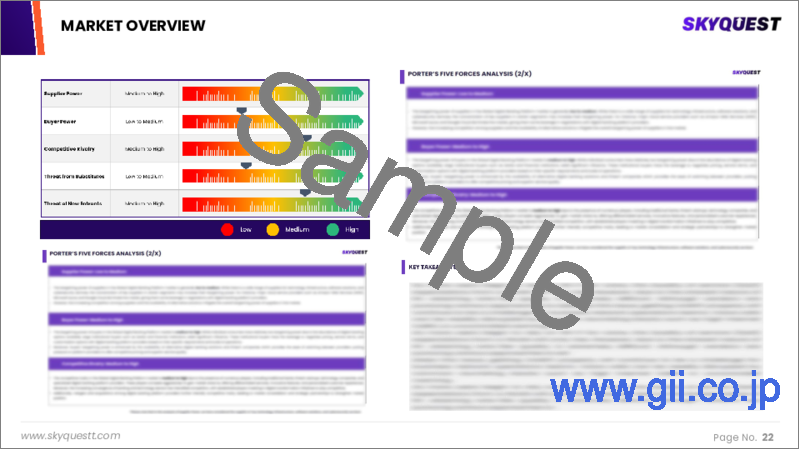|
|
市場調査レポート
商品コード
1605412
プローブカードの市場規模、シェア、成長分析、タイプ別、技術別、用途別、地域別 - 産業予測、2024年~2031年Probe Card Market Size, Share, Growth Analysis, By Type (Standard, Advanced Probe Card), By Technology, By Application, By Region - Industry Forecast 2024-2031 |
||||||
|
|||||||
| プローブカードの市場規模、シェア、成長分析、タイプ別、技術別、用途別、地域別 - 産業予測、2024年~2031年 |
|
出版日: 2024年12月02日
発行: SkyQuest
ページ情報: 英文 157 Pages
納期: 3~5営業日
|
全表示
- 概要
- 目次
プローブカードの市場規模は、2022年に23億7,375万米ドルなり、2023年の26億3,014万米ドルから、2031年までには26億3,056万米ドルに成長し、予測期間(2024年~2031年)のCAGRは10.8%で成長する見通しです。
プローブカード市場は、エレクトロニクスや製造業を中心とした様々なエンドユーザー分野での半導体需要の急増により、大幅な成長が見込まれています。プローブカードは、電子テストシステムと半導体ウエハーとの重要な仲介役として、製造工程における集積回路の完全性を検査・検証する上で重要な役割を果たしています。電子機器の普及に伴い、集積回路の高度化がますます必要とされているため、高品質なプローブカードに対する需要は、予測期間を通じて堅調に推移すると予想されます。さらに、半導体メーカーはこの需要の高まりに対応するため、生産能力の拡張に積極的に投資しており、業務を合理化するために新たな施設を設立しています。このような戦略的注力は、生産効率を高めるだけでなく、半導体技術の急速な進歩をサポートし、メーカーが市場の進化するニーズに確実に応えられるようにすることを目的としています。その結果、プローブカード業界は、半導体セクターの広範な成長と一致するダイナミックな情勢を反映し、こうした動向から利益を得るのにふさわしい立場にあります。
目次
イントロダクション
- 調査の目的
- 調査範囲
- 定義
調査手法
- 情報調達
- 二次データと一次データの方法
- 市場規模予測
- 市場の前提条件と制限
エグゼクティブサマリー
- 世界市場の見通し
- 供給と需要の動向分析
- セグメント別機会分析
市場力学と見通し
- 市場概要
- 市場規模
- 市場力学
- 促進要因と機会
- 抑制要因と課題
- ポーター分析と影響
- 競争企業間の敵対関係
- 代替品の脅威
- 買い手の交渉力
- 新規参入業者の脅威
- 供給企業の交渉力
主要な市場の考察
- 主要な成功要因
- 競合の程度
- 主要な投資機会
- 市場エコシステム
- 市場の魅力指数(2023年)
- PESTEL分析
- マクロ経済指標
- バリューチェーン分析
- 価格分析
- 技術の進歩
- 規制情勢
- ケーススタディ
世界のプローブカードの市場規模:タイプ別・CAGR(2024年~2031年)
- スタンダードプローブカード
- アドバンストプローブカード
世界のプローブカードの市場規模:技術別・CAGR(2024年~2031年)
- MEMS
- 垂直型
- カンチレバー
- 専門
- その他の技術
世界のプローブカードの市場規模:用途別・CAGR(2024年~2031年)
- DRAM
- フラッシュ
- ファウンドリ・ロジック
- パラメトリック
- その他の用途
世界のプローブカードの市場規模:地域別・CAGR(2024年~2031年)
- 北米
- 米国
- カナダ
- 欧州
- 英国
- ドイツ
- スペイン
- フランス
- イタリア
- その他欧州地域
- アジア太平洋
- 中国
- インド
- 日本
- 韓国
- その他アジア太平洋
- ラテンアメリカ
- ブラジル
- その他ラテンアメリカ地域
- 中東・アフリカ
- GCC諸国
- 南アフリカ
- その他中東・アフリカ
競合情報
- 上位5社の比較
- 主要企業の市場ポジショニング(2023年)
- 主な市場企業が採用した戦略
- 市場の最近の動向
- 企業の市場シェア分析(2023年)
- 主要企業の企業プロファイル
- 会社概要
- 製品ポートフォリオ分析
- 企業のセグメント別シェア分析
- 収益の前年比比較(2021年~2023年)
主要企業プロファイル
- General Mills Inc.
- Amway
- Conagra Brands Inc.
- Cargill Incorporate
- Abbott Laboratories
- Kraft Foods Group Inc.
- The Coca-Cola Company
- PepsiCo Inc.
- Atkins Nutritionals Inc.
- Brunswick Corporation
- Nidec Corporation
- Feinmetall
- Advantest
- Japan Electronic Materials Corp.
- Micronics Japan Co., Ltd.
- Technoprobe S.p.A.
- MPI Corporation
- Teseda Corporation
- JEM America Corp.
- Wentworth Laboratories Ltd.
結論と提言
Probe Card Market size was valued at USD 2373.75 million in 2022 and is poised to grow from USD 2630.14 million in 2023 to USD 2630.56 million by 2031, growing at a CAGR of 10.8% in the forecast period (2024-2031).
The probe card market is poised for substantial growth, driven by the surging demand for semiconductors across various end-user sectors, particularly electronics and manufacturing. As a critical intermediary between electronic test systems and semiconductor wafers, probe cards play an essential role in inspecting and validating the integrity of integrated circuits during the manufacturing process. With the proliferation of electronic devices necessitating increasingly sophisticated integrated circuits, the demand for high-quality probe cards is expected to remain robust throughout the forecast period. Moreover, semiconductor manufacturers are actively investing in the expansion of their production capabilities to accommodate this heightened demand, establishing new facilities to streamline their operations. This strategic focus not only aims to enhance production efficiency but also to support the rapid advancements in semiconductor technology, ensuring that manufacturers can meet the evolving needs of the market. As a result, the probe card industry is well-positioned to benefit from these trends, reflecting a dynamic landscape that aligns with the broader growth of the semiconductor sector.
Top-down and bottom-up approaches were used to estimate and validate the size of the Probe Card market and to estimate the size of various other dependent submarkets. The research methodology used to estimate the market size includes the following details: The key players in the market were identified through secondary research, and their market shares in the respective regions were determined through primary and secondary research. This entire procedure includes the study of the annual and financial reports of the top market players and extensive interviews for key insights from industry leaders such as CEOs, VPs, directors, and marketing executives. All percentage shares split, and breakdowns were determined using secondary sources and verified through Primary sources. All possible parameters that affect the markets covered in this research study have been accounted for, viewed in extensive detail, verified through primary research, and analyzed to get the final quantitative and qualitative data.
Probe Card Market Segmental Analysis
Global Probe Card Market is segmented by Type, by Technology, by Application, and by Region. Based on Type, the market is segmented into Standard Probe Card, Advanced Probe Card. Based on Technology, the market is segmented into MEMS, Vertical, Cantilever, Speciality, Other Technologies. Based on Application, the market is segmented into DRAM, Flash, Foundry and Logic, Parametric, Other Applications. Based on region, the market is segmented into North America, Europe, Asia Pacific, Latin America and Middle East & and Africa.
Driver of the Probe Card Market
The Global Probe Card Market is primarily driven by the increasing demand for electronic testing within the semiconductor industry. While consumer awareness regarding the advantages of probe card solutions remains low, hindering market expansion, strategic partnerships and collaborative efforts among companies present new growth opportunities. Nevertheless, the high cost associated with probe card solutions could restrain market progression. Additionally, the rise of advanced technologies such as autonomous driving, artificial intelligence, 5G, and the Internet of Things is further enhancing semiconductor usage, thus positively impacting the probe card market. Key industry players are engaging in mergers and acquisitions to bolster their competitive edge, with the need for specialized testing equipment growing as semiconductor device manufacturers adapt to component miniaturization.
Restraints in the Probe Card Market
The Probe Card market is facing significant restraints due to the growing demand for intricate electronic circuitry and the rapid technological advancements in consumer electronics. These factors create challenges for market growth, as developing complex probe cards is often a time-consuming and labor-intensive process. Manufacturers must continuously upgrade and enhance their existing facilities to keep pace with evolving technological requirements, which can strain resources and slow production. Consequently, these obstacles may hinder the overall expansion of the Probe Card market, making it difficult for companies to meet the increasing demands of modern electronic applications effectively.
Market Trends of the Probe Card Market
The probe card market is poised for significant growth, driven by the increasing demand for compact and portable electronic devices. As semiconductor OEMs prioritize research and development for micro components, the trend toward electronic component miniaturization necessitates upgrades in manufacturing facilities to accommodate emerging technologies such as MEMS and 3D ICs. Consequently, there is a heightened demand for advanced testing equipment that ensures the reliability and performance of these miniaturized devices. This shift in focus among semiconductor manufacturers underscores the vital role of probe cards, positioning them as essential tools for quality assurance in a rapidly evolving electronics landscape during the forecast period.
Table of Contents
Introduction
- Objectives of the Study
- Scope of the Report
- Definitions
Research Methodology
- Information Procurement
- Secondary & Primary Data Methods
- Market Size Estimation
- Market Assumptions & Limitations
Executive Summary
- Global Market Outlook
- Supply & Demand Trend Analysis
- Segmental Opportunity Analysis
Market Dynamics & Outlook
- Market Overview
- Market Size
- Market Dynamics
- Driver & Opportunities
- Restraints & Challenges
- Porters Analysis & Impact
- Competitive rivalry
- Threat of substitute
- Bargaining power of buyers
- Threat of new entrants
- Bargaining power of suppliers
Key Market Insights
- Key Success Factors
- Degree of Competition
- Top Investment Pockets
- Market Ecosystem
- Market Attractiveness Index, 2023
- PESTEL Analysis
- Macro-Economic Indicators
- Value Chain Analysis
- Pricing Analysis
- Technological Advancement
- Regulatory Landscape
- Case Studies
Global Probe Card Market Size by Type & CAGR (2024-2031)
- Standard Probe Card
- Advanced Probe Card
Global Probe Card Market Size by Technology & CAGR (2024-2031)
- MEMS
- Vertical
- Cantilever
- Speciality
- Other Technologies
Global Probe Card Market Size by Application & CAGR (2024-2031)
- DRAM
- Flash
- Foundry and Logic
- Parametric
- Other Applications.
Global Probe Card Market Size by Region & CAGR (2024-2031)
- North America, (by Type, by Technology, by Application)
- US
- Canada
- Europe, (by Type, by Technology, by Application)
- UK
- Germany
- Spain
- France
- Italy
- Rest of Europe
- Asia-Pacific, (by Type, by Technology, by Application)
- China
- India
- Japan
- South Korea
- Rest of Asia Pacific
- Latin America, (by Type, by Technology, by Application)
- Brazil
- Rest of Latin America
- Middle East & Africa, (by Type, by Technology, by Application)
- GCC Countries
- South Africa
- Rest of Middle East & Africa
Competitive Intelligence
- Top 5 Player Comparison
- Market Positioning of Key Players, 2023
- Strategies Adopted by Key Market Players
- Recent Developments in the Market
- Company Market Share Analysis, 2023
- Company Profiles of All Key Players
- Company Details
- Product Portfolio Analysis
- Company's Segmental Share Analysis
- Revenue Y-O-Y Comparison (2021-2023)
Key Company Profiles
- General Mills Inc.
- Company Overview
- Business Segment Overview
- Financial Updates
- Key Developments
- Amway
- Company Overview
- Business Segment Overview
- Financial Updates
- Key Developments
- Conagra Brands Inc.
- Company Overview
- Business Segment Overview
- Financial Updates
- Key Developments
- Cargill Incorporate
- Company Overview
- Business Segment Overview
- Financial Updates
- Key Developments
- Abbott Laboratories
- Company Overview
- Business Segment Overview
- Financial Updates
- Key Developments
- Kraft Foods Group Inc.
- Company Overview
- Business Segment Overview
- Financial Updates
- Key Developments
- The Coca-Cola Company
- Company Overview
- Business Segment Overview
- Financial Updates
- Key Developments
- PepsiCo Inc.
- Company Overview
- Business Segment Overview
- Financial Updates
- Key Developments
- Atkins Nutritionals Inc.
- Company Overview
- Business Segment Overview
- Financial Updates
- Key Developments
- Brunswick Corporation
- Company Overview
- Business Segment Overview
- Financial Updates
- Key Developments
- Nidec Corporation
- Company Overview
- Business Segment Overview
- Financial Updates
- Key Developments
- Feinmetall
- Company Overview
- Business Segment Overview
- Financial Updates
- Key Developments
- Advantest
- Company Overview
- Business Segment Overview
- Financial Updates
- Key Developments
- Japan Electronic Materials Corp.
- Company Overview
- Business Segment Overview
- Financial Updates
- Key Developments
- Micronics Japan Co., Ltd.
- Company Overview
- Business Segment Overview
- Financial Updates
- Key Developments
- Technoprobe S.p.A.
- Company Overview
- Business Segment Overview
- Financial Updates
- Key Developments
- MPI Corporation
- Company Overview
- Business Segment Overview
- Financial Updates
- Key Developments
- Teseda Corporation
- Company Overview
- Business Segment Overview
- Financial Updates
- Key Developments
- JEM America Corp.
- Company Overview
- Business Segment Overview
- Financial Updates
- Key Developments
- Wentworth Laboratories Ltd.
- Company Overview
- Business Segment Overview
- Financial Updates
- Key Developments





